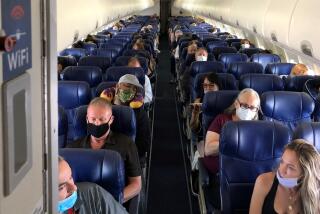FAA Plans to Set Time Limits for Wing De-Icing
- Share via
WASHINGTON — To prevent air crashes caused by the formation of ice on jet wings, the Federal Aviation Administration plans to limit the time between de-icing procedures and takeoff, acting FAA Administrator Barry L. Harris indicated Thursday.
Although details remain to be worked out, this and other steps to cope with the problem will be implemented before this winter, he said at an international de-icing conference in Reston, Va.
The move follows criticism that the FAA and the airline industry have been too slow in responding to a problem that has plagued jet aircraft in wintry weather. Ice on aircraft wings has been blamed in 15 jetliner crashes in the last two decades--10 alone of Fokker-28 and Douglas DC-9 aircraft, which are particularly susceptible to the problem because of their design.
The latest crash tentatively attributed to icy buildup that hampered lift was of a USAir Fokker-28 airliner at New York’s LaGuardia Airport in March. Twenty-seven of the 51 people on board were killed. In that incident, about three-tenths of an inch of snow fell in the 35 minutes between the last de-icing procedure and takeoff of the Dutch-built jet.
Current FAA regulations, which date to the 1950s, only direct a pilot not to take off with ice or snow on lifting surfaces. The determination that a wing is “clean” can be made simply by eye or by hand from inside or outside the plane.
“Unless we hear better from you,” Harris said at the opening session of the conference, the FAA is prepared to “issue mandatory rules requiring specific time limits between de-icing and takeoff.” He asked for participants’ recommendations on how long that time should be, on which de-icing fluids work best under various conditions and on hazards of the fluids to people and the environment.
The groups were to report their recommendations today, and the FAA will take them under advisement.
More to Read
Inside the business of entertainment
The Wide Shot brings you news, analysis and insights on everything from streaming wars to production — and what it all means for the future.
You may occasionally receive promotional content from the Los Angeles Times.










